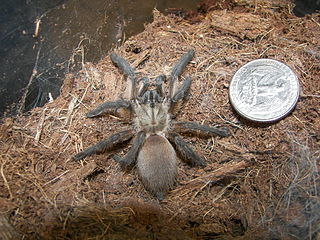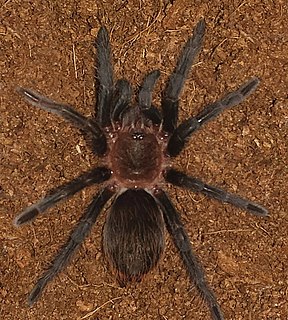
Chromatopelma is a monotypic genus of South American tarantulas containing the single species, Chromatopelma cyaneopubescens. Commonly known as greenbottle blue tarantulas due to their metallic blue legs and blue-green carapace, they are very active and fast-growing tarantulas that are particularly attractive to hobbyists. They are native to the Paraguaná Peninsula.

Ornithoctoninae is a subfamily of tarantulas found in Southeast Asia. It was first erected in 1895 by Reginald Innes Pocock based on the type specimen Ornithoctonus andersoni.

Cyriopagopus schmidti is a species of spider in the family Theraphosidae (tarantulas), found in China and Vietnam. It is one of a number of species known as "Chinese bird spider" and "Chinese earth tiger". Haplopelma huwenum was synonymized with this species in 2008. Spiders under this name and its synonyms have been shown to produce toxins called huwentoxins.

Brachypelma albiceps is a species of spider in the tarantula family, Theraphosidae. It is known as the Mexican golden red rump tarantula or the Amula red rump tarantula. The carapace is a light golden color and the abdomen dark, covered with long red hairs. Females typically live for about 15 years. Males usually live about 5 years or up to 12 months after the last molt.

The Aviculariinae are a subfamily of spiders in the family Theraphosidae (tarantulas). They can be distinguished from other theraphosids by a number of characters. Their legs have no or few spines on the underside of the tibial and metatarsal joints of the legs. The last two leg joints have brushes of hairs (scopulae) that extend sideways, particularly on the front legs, giving them a spoon-like (spatulate) appearance. Females have two completely separated spermathecae.

Cyriopagopus is a genus of southeast Asian tarantulas found from Myanmar to the Philippines. As of March 2017, the genus includes species formerly placed in Haplopelma. It was first described by Eugène Louis Simon in 1887.
The Selenogyrinae are a subfamily of tarantulas found in Africa and Asia.
Ozopactus is a monotypic genus of Venezuelan tarantulas containing the single species, Ozopactus ernsti. It was first described by Eugène Louis Simon in 1889, and is found in Venezuela. They have an enlarged sternum and an enlarged maxillae. The front of the ocularium is no longer than the back.

The Eumenophorinae are a subfamily of tarantula spiders. They are known from genera distributed across Africa, southwestern countries in Saudi Arabia, and Madagascar and the associated islands.
Reversopelma is a monotypic genus of spider in the family Theraphosidae. It is Theraphosine and is native to Peru and Ecuador. The single species is Reversopelma petersi.

Sericopelma is a genus of tarantula, found in Central America from Nicaragua to Panama. The limits of the genus and its distribution have long been confused; it is closely related to the genus Aphonopelma. Sericopelma species are among the largest found in Central America. They can be kept as pets, although at least one species has been described as "very aggressive".
Aphonopelma caniceps is a species of spider in the family Theraphosidae, found in Mexico. This species was first described as Eurypelma caniceps in 1891 by Eugène Simon, and was transferred to the genus, Aphonopelma, in 1993 by Günter Schmidt.
Aphonopelma serratum is a species of spider in the family Theraphosidae, found in Mexico. This species was first described as Eurypelma serratum in 1891 by Eugène Simon, and was transferred to the genus, Aphonopelma, in 1993 by Günter Schmidt.

Poecilotheria rufilata, also known as the red slate ornamental, reddish parachute spider, Travancore slate-red, or rufus parachute spider, is an arboreal tarantula. It is endemic to South Western Ghats of India. It is classed as "endangered", threatened by habitat loss and smuggling for the pet trade.

Avicularia purpurea, also called purple tree tarantula, Ecuadorian purple tarantula or Ecuador purple pinktoe, is a species of spider belonging to the family Theraphosidae (tarantulas).

Thrixopelma is a genus of South American tarantulas that was first described by Günter E. W. Schmidt in 1994. They are medium to large tarantulas, usually being 35mm to 60mm in body length.

Cyrtopholis is a genus of tarantulas that was first described by Eugène Louis Simon in 1892.

Tliltocatl verdezi is a species of spiders in the family Theraphosidae (tarantulas), found in Mexico.

Tliltocatl is a genus of North American tarantulas that was split off from Brachypelma in 2020. They are also large burrowing tarantulas, but don't have the striking red leg markings of Brachypelma species. A female T. vagans can grow up to 50 mm (2.0 in) long and legs can get as long as 55 mm (2.2 in). They are found predominantly in Mexico, with some species native to Central America. The name is derived from two Nahuatl words, "tlil", meaning "black", and "tocatl", meaning "spider". Habitat destruction and collection for the pet trade has led to this and Brachypelma to be protected under International Convention on International Trade of Endangered Species rules, beginning with B. smithi.

Grammostola grossa, the Guarani giant tarantula, is a tarantula that, like all species of the genus Grammostola, is native to South America. It occurs in Brazil, Paraguay, Uruguay and Argentina. The species was described in 1871 by the Austrian Anton Ausserer, but only received its trivial name Guarani giant Tarantula in the 21st century by the anthropologist Nils Seethaler. The name was given to the spider because of its abundance in the Guarani settlement area, whose agriculture and the associated clearing of forests extended its range.















